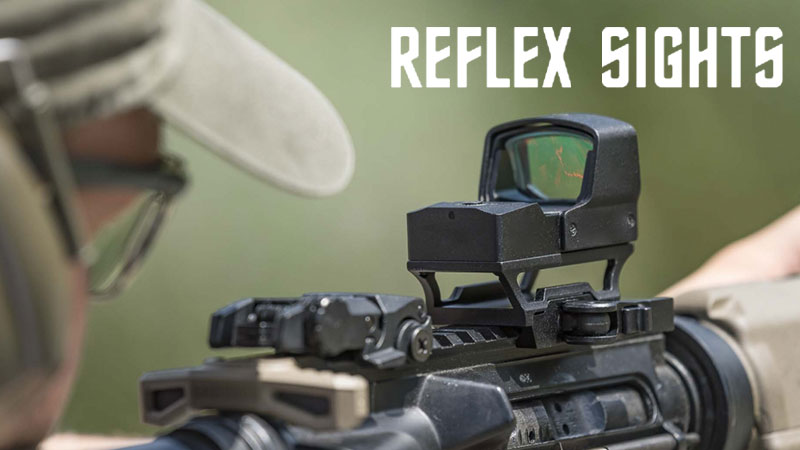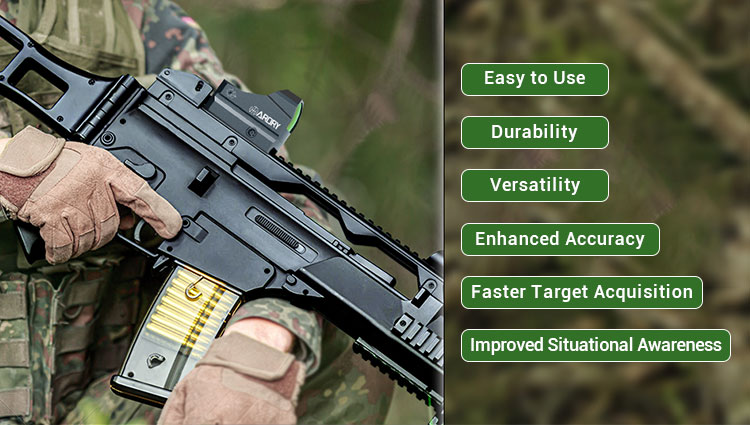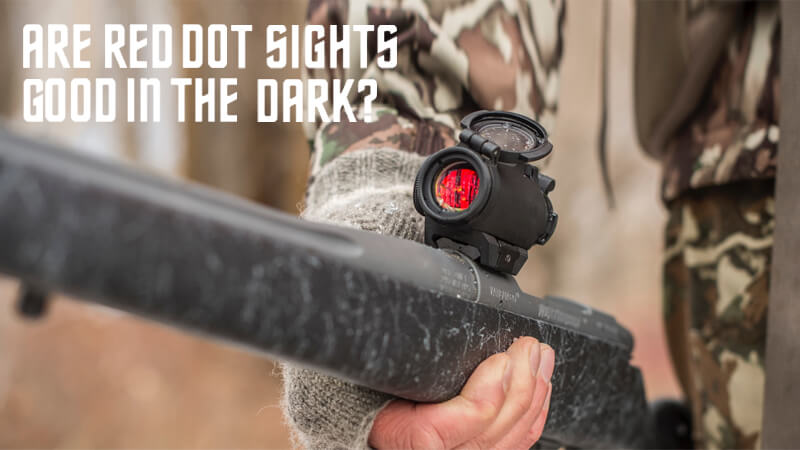Do you like shooting? Do you want to improve your accuracy without compromising your fun? If so, you should check out ARORY’s reflex sight!
Reflex sights are a firearm accessory that makes aiming much easier and helps shooters hit their targets. It requires some adjustments, but it’s easy to learn if you take the proper steps.
This article will explain reflex sight in detail, its advantages, and most importantly, how to operate it properly.
What Is a Reflex Sight?
The reflex sight is also known as a Red dot sight. A red dot or reticle is projected onto a glass lens using this particular type of optic. The shooter looks through this to aim the weapon. These are frequently found on pistols, rifles, shotguns, and bows used for archery.
The reflex sight makes aiming and shooting more precise. Its reticle has a distinct and visible targeting point that makes this possible. In most cases, the red dot or reticle can be adjusted for brightness, windage, and elevation. Adjustments allow the shooter to customize the sight to their preferences and shooting circumstances. Some offer additional features, such as a circle-dot reticle or various reticle choices.
In general, reflex sight is simpler to use. In addition, it takes less time to generate a sight picture than traditional iron sights or scopes. However, the target must be the shooter’s primary attention in aligning the red dot or reticle. As a result, it is more popular for self-defense, target practice, and other shooting sports where accuracy and speed are crucial.
Types of Reflex Sight
Each reflex sights have unique qualities and features that set them apart from the others. Here are some typical varieties of it:
- Red Dot Sights: Red dot sights are the most common type of reflex sight. It uses a single red dot as the aiming reticle, which spreads over the target when the shooter looks through the sight. Red dot sights are simple to use and are well-suited to a wide range of shooting situations.
- Multi-Dot Sights: Multi-dot sights are similar to red dot sights. It features multiple red dots or reticles instead of just one. It can be useful for shooting at multiple targets or fine-tuning the point of impact at different distances.
- Circle-Dot Sights: Circle-dot sights are reflex sights that feature a circle-dot reticle. The outer circle helps the shooter align the sight quickly, while the inner dot provides a precise aiming point. Circle-dot sights are popular for close-range shooting and useful for shooting on the move.
- Holographic Sights: Holographic sights use a holographic reticle, which is a laser-etched image that appears to float in front of the shooter’s eye. Holographic sights are more complex and expensive than others. They offer a wide field of view and can be very accurate.
- Magnified Reflex Sights: Some offer a magnification feature, which allows the shooter to zoom in on the target for more precise shots. These are typically more expensive than non-magnified ones and are best suited for longer-range shooting.
The best reflex sight for you will ultimately depend on your shooting requirements and preferences. So before making a choice, consider the kind of shooting you’ll be performing, your spending limit, and any other features you might want.
What Are the Benefits of Reflex Sight?
Reflex sights can provide shooters and hunters with several advantages.
- Enhanced Accuracy: Its reticle, or aiming point, is typically straightforward to perceive, which can help the shooter aim their firearm more precisely.
- Faster Target Acquisition: The shooter can quickly and easily acquire their target because the reticle is projected directly onto the sight’s lens. It can be very helpful in fast-paced shooting scenarios.
- Improved Situational Awareness: A large field of view is typical in reflex sights. It can aid accurate firearm aiming while allowing the shooter to stay aware of their surroundings.
- Easy to Use: Even for shooters with little expertise, reflex sights are typically quite simple to operate. They can be more user-friendly since they do not need the shooter to align their eye the same way when using traditional iron sights.
- Durability: Strong materials, including aircraft-grade aluminum, are frequently used to create reflex sights. It can protect them from harm caused by rigorous handling or harsh weather.
- Versatility: Reflex sights are a versatile choice for various shooting and hunting situations since you can install them on a wide range of firearms, including rifles, shotguns, and pistols.
Tips for Choosing the Ideal Reflex Sight
There are a few key factors to consider when choosing the best reflex sight for your needs:
- Compatibility: Check its compatibility with your firearm and the mounting system. It’s imperative to ensure your luminous dot is appropriate for your configuration since there are multiple designs for different guns and mounting systems.
- Reticle: Think about the reticle style you like best. While some have a straightforward red dot, others have more complex reticles with numerous aiming locations or a circle-dot reticle. Pick the reticle that suits your needs and shooting style the best.
- Construction: Select long-lasting, sturdy sights. It must be durable enough to survive the recoil of your firearm and immune to moisture and other environmental elements.
- Battery Life: Consider its battery life. If you want to use it for lengthy periods, it can be crucial that certain sights offer longer battery lives than others.
- Price: One of the things to look for when choosing a collimator is the price tag. There is a wide range of prices to choose from, so find one that is suited to your budget without compromising quality.
By considering these factors and doing your research, you should be able to find the best reflex sight for your needs.
How Does a Reflex Sight Work?
A red dot or reticle is projected onto a glass lens by a reflex sight to function. A tiny LED or other light source produces the red dot or reticle. Typically, you can locate the light source behind the glass lens.
The red dot or reticle emerges on the target when the shooter looks through the reflex sight. After lining up the red dot or reticle with the mark, the shooter fires the weapon.
Adjustable brightness settings are available on several reflex sights. It enables the shooter to modify the red dot’s or reticle’s brightness to suit the shooting environment. They also feature movable height and windage controls. Additionally, it enables the shooter to precisely control the rounds’ point of impact.
Reflex sights are made to be portable and lightweight, thus making them easier to be fitted on a range of firearms. In addition, red dot sight manufacturing is very dependable, and some versions even feature a shock-resistant construction. It also incorporates waterproofing so that it can survive rigorous handling and bad weather.
How to Use a Reflex Sight?
Using a reflex sight is generally quite easy. Here are the steps to follow:
- Install the Reflex Sight on Your Rifle: You must first mount it on your weapon using a mounting base or mount. Before installing, make sure it is compatible with your rifle and mount because certain sights are designed to be used with a particular firearm or mounting system.
- Reflex Sight Adjustment: You should tweak it to your preference only after it is attached to your firearm. You should adjust the red dots or reticle brightness and the windage and elevation settings. It ensures that the bullet’s point of impact is where you want it to be.
- Obtain a Sight Picture: You must first obtain the target’s sight picture to use the reflex sight. You can do this by lining up the target with the red dot or reticle. Hold the firearm in a steady shooting position and glance through it. The target should have the red dot or reticle superimposed over it.
- Aim and Fire: You are now ready to fire once you have established a sight picture and the red dot or reticle is aligned with the target. Squeeze the trigger after aiming the weapon at the target.
Tips for Using a Reflex Sight Effectively:
- Spend some time becoming accustomed to and practicing with the reflex sight. It will appear more natural if you use it more frequently.
- Always focus on the target rather than the reticle or red dot. It’s simple to become obsessed with the red dot, but it’s crucial to keep in mind that it’s just a tool for pointing rather than the actual goal.
- If you are having trouble forming a sight picture, try closing one eye or slightly moving your head.
- The reticle or dot’s size, shape, and brightness should all be taken into consideration. Different shooting scenarios may benefit from different reticle sizes and shapes, and the brightness level should be adjusted to meet the lighting.
Following these steps and tips, you should be able to use a reflex sight effectively and improve your shooting accuracy and speed.
Achieve Precision Shooting with ARORY’s Reflex Sight
Are you tired of struggling to get a clear sight picture with your iron sights or traditional scope?
Upgrade to a reflex sight from ARORY and experience the difference! Our selection offers the latest red dot technology, providing you with a quick and easy-to-use aiming solution for any shooting situation. And with our wide range of options, we ensure you find the perfect fit for your needs and budget.
So why wait? Start exploring our selection, and take your shooting to the next level!
Takeaway
In conclusion, reflex sight is an extremely useful tool that can give you a tremendous advantage when shooting. It’s simple to use, easy to adapt, and can help you become a better shooter in no time.
You will have the knowledge and abilities required to become the accurate marksman or hunter that you want to be once you comprehend how it operates and what is needed to use it well. Nothing will prevent you from attaining your goals once you have this insight.
So don’t hesitate – dive into the world of reflex sights today for an experience like no other!
FAQ
1. What is a red dot sight’s effective range?
Red dot sight is best for close-range shooting, typically around 100 yards or less. They are easy and basic to use, especially for beginners.
2. Is zeroing applicable to red dot sight?
Red dot sights require correct zeroing to function effectively, like rifle scopes.
3. Do reflex sights need batteries?
Yes, reflex sights typically need batteries to power the electronic components that allow the user to see the reticle. The battery is usually located at the base of the sight. It can be easily replaced when it runs out of power. Some have a longer battery life than others.










Leave A Comment
You must be logged in to post a comment.